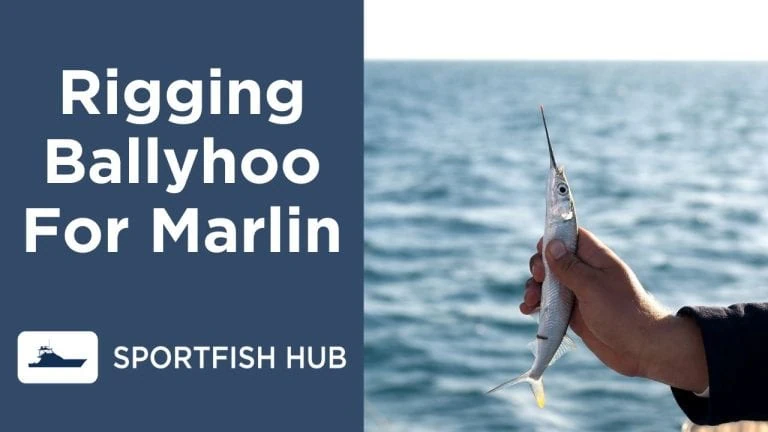Catching a marlin is a thrilling experience for any angler. One of the most effective baits for this majestic fish is the ballyhoo. In this guide, we will walk you through various methods of rigging a ballyhoo for marlin fishing, ensuring that your bait is irresistible to these magnificent creatures.
Table of Contents
- Rigging Methods Covered in This Guide
- What You Will Need To Rig Your Ballyhoo
- Standard Rigging Method
- Rigging Rubber Ballyhoo
- Rigging Ballyhoo with a Chugger Head
- Rigging Ballyhoo with a Pin Rig
- Rigging Ballyhoo with a Chugger Head Pin Rig
- Rigging a Skirted Ballyhoo
- Rigging Live Ballyhoo
- FAQ:
- What are the benefits of using a swivel when rigging ballyhoo?
- What is a pitch bait ballyhoo?
- How far behind the boat should I troll?
- What size hooks for ballyhoo?
- Conclusion
Rigging Methods Covered in This Guide
- Standard Rigging Method: This method involves inserting the hook through the gill cover and out through the belly of the ballyhoo. It’s a simple and effective method suitable for both beginners and experienced anglers.
- Rigging Rubber Ballyhoo: An alternative to using fresh or brined ballyhoo, this method involves using rubber ballyhoo, which is favored by some marlin fishermen due to its durability and effectiveness.
- Rigging Ballyhoo with a Chugger Head: This method gives the ballyhoo a skipping action in the water, mimicking a fleeing baitfish. It involves attaching a chugger head to the ballyhoo and inserting the hook through the gill cover and out through the belly.
- Rigging Ballyhoo with a Pin Rig: The Pin Rig method positions the hook towards the front of the ballyhoo, which can help increase the hookup ratio. It involves inserting a pin through the lower jaw of the ballyhoo and securing the hook to the leader.
- Rigging Ballyhoo with a Chugger Head Pin Rig: This method combines the benefits of a chugger head with the effectiveness of a pin rig. It positions the hook towards the front of the ballyhoo, increasing the hookup ratio, while the chugger head gives the ballyhoo a skipping action in the water.
- Rigging a Skirted Ballyhoo– This method involves adding a colorful skirt to your ballyhoo bait, enhancing its appeal to marlin by mimicking the look of a small school of fish.
- Rigging Live Ballyhoo– This method is often best reserved for sailfish or striped marlin.
Each of these methods has its advantages and can be effective in different fishing conditions. As you read through this guide, you’ll learn how to execute each method step by step, helping you become a more versatile and successful marlin angler. Let’s get started!
What You Will Need To Rig Your Ballyhoo
Before we delve into the various methods of rigging a ballyhoo for marlin fishing, let’s go over the items you’ll need:
- Fresh, brined, or rubber ballyhoo
- Circle hooks or J-hooks (depending on your preference and local regulations)
- Leader material (fluorocarbon is recommended)
- Crimps and a crimping tool
- Rigging wire or floss
- Rigging springs
- Skirted lures (optional)
- Chugger heads (if using the chugger head method)
- Pin rigs (if using the pin rig methods)
Having these items on hand will ensure you’re prepared to rig a ballyhoo using any of the methods we’ll discuss in this guide.
Standard Rigging Method
The standard rigging method is a simple and effective way to rig a ballyhoo for marlin fishing. Here’s how to do it:
- Prepare the Ballyhoo: Start by removing the innards of the Ballyhoo. This is done by applying gentle pressure along the belly of the fish, pushing towards the tail. This step is crucial as it prevents the bait from spinning in the water.
- Insert the Hook: Open the gill cover and slide the hook through, being careful not to tear the belly. As the hook starts to bend, gently turn it and push it out through the belly.
- Secure the Hook: Using a crimping tool, secure the hook to the leader. Ensure the crimp is smooth and even to prevent any damage to the line.
- Check the Rig: Before casting, check the rig to ensure the ballyhoo swims naturally in the water. If it spins or doesn’t swim straight, adjust the rig as necessary.
The standard rigging method is a great starting point for beginners and a reliable method for experienced anglers. It provides a straightforward way to rig a ballyhoo, ensuring your bait is ready to attract marlin.
Rigging Rubber Ballyhoo
An alternative to using fresh or brined ballyhoo is to use a rubber ballyhoo. This method is favored by some marlin fishermen due to its durability and effectiveness.
- Select the Right Hook: Choose a J-hook for this method as it works well with the rubber ballyhoo.
- Insert the Hook: Slide the hook through the rubber ballyhoo, ensuring it’s positioned correctly for optimal swimming action.
- Secure the Hook: Use a crimping tool to secure the hook to the leader. Make sure the crimp is tight and secure.
- Add a Skirt (Optional): If you’re using a skirted lure, slide it down the leader until it sits snugly over the head of the rubber ballyhoo.
Rigging Ballyhoo with a Chugger Head
Another popular method for rigging ballyhoo for marlin involves the use of a chugger head. This method gives the ballyhoo a skipping action in the water, mimicking a fleeing baitfish.
- Prepare the Ballyhoo: Follow the same steps as above to clean and prepare the Ballyhoo.
- Attach the Chugger Head: Slide the chugger head onto the leader and position it over the head of the ballyhoo. The chugger head should fit snugly and not interfere with the hook.
- Insert the Hook: Insert the hook through the gill cover and out through the belly of the ballyhoo. Secure the hook to the leader with a crimp.
- Secure the Chugger Head: Use rigging wire or floss to secure the chugger head to the ballyhoo. This prevents the chugger head from sliding during the cast or troll.
Rigging Ballyhoo with a Pin Rig
The Pin Rig method is a popular choice for anglers targeting marlin. This method positions the hook towards the front of the ballyhoo, which can help increase the hookup ratio.
- Prepare the Ballyhoo: Follow the same steps as above to clean and prepare the Ballyhoo.
- Insert the Pin: The pin rig consists of a hook attached to a wire with a pin on the end. Insert the pin through the lower jaw of the ballyhoo, exiting through the upper jaw.
- Position the Hook: The hook should be positioned towards the front of the ballyhoo, with the point facing upwards. This positioning helps to increase the hookup ratio.
- Secure the Rig: Use a crimping tool to secure the rig to the leader. Make sure the crimp is tight and secure.
- Check the Rig: Before casting, check the rig to ensure the ballyhoo swims naturally in the water. If it spins or doesn’t swim straight, adjust the rig as necessary.
Rigging Ballyhoo with a Chugger Head Pin Rig
The Chugger Head Pin Rig method combines the benefits of a chugger head with the effectiveness of a pin rig. This method positions the hook towards the front of the ballyhoo, increasing the hookup ratio, while the chugger head gives the ballyhoo a skipping action in the water.
- Prepare the Ballyhoo: Follow the same steps as above to clean and prepare the Ballyhoo.
- Attach the Chugger Head: Slide the chugger head onto the leader and position it over the head of the ballyhoo. The chugger head should fit snugly and not interfere with the hook.
- Insert the Pin: The pin rig consists of a hook attached to a wire with a pin on the end. Insert the pin through the loop at the end of the chugger head, ensuring it exits through the upper jaw of the ballyhoo.
- Position the Hook: The hook should be positioned towards the front of the chugger head, with the point facing upwards. This positioning helps to increase the hookup ratio.
- Secure the Rig: Use a crimping tool to secure the rig to the leader. Make sure the crimp is tight and secure.
- Check the Rig: Before casting, check the rig to ensure the ballyhoo swims naturally in the water. If it spins or doesn’t swim straight, adjust the rig as necessary.
Rigging a Skirted Ballyhoo
Adding a skirt to your ballyhoo can make it even more enticing to marlin. The skirt adds color and movement, mimicking the look of a small school of fish. Here’s how to rig a skirted ballyhoo:
- Prepare the Ballyhoo: Follow the same steps as above to clean and prepare the Ballyhoo.
- Slide on the Skirt: Before you start rigging, slide the skirt onto the leader. It should be positioned so that it will sit just ahead of the ballyhoo once the bait is rigged.
- Insert the Hook: Open the gill cover and slide the hook through, being careful not to tear the belly. As the hook starts to bend, gently turn it and push it out through the belly.
- Secure the Hook: Using a crimping tool, secure the hook to the leader. Ensure the crimp is smooth and even to prevent any damage to the line.
- Position the Skirt: Slide the skirt down the leader until it sits just ahead of the ballyhoo. It should cover the head of the ballyhoo but not obscure the hook.
- Check the Rig: Before casting, check the rig to ensure the ballyhoo swims naturally in the water and the skirt is positioned correctly. If it spins or doesn’t swim straight, adjust the rig as necessary.
Rigging a skirted ballyhoo is a great way to add some extra flash and movement to your bait, making it even more attractive to marlin.
Rigging Live Ballyhoo
FAQ:
-
What are the benefits of using a swivel when rigging ballyhoo?
Using a swivel when rigging ballyhoo allows the bait to spin freely without binding up when being trolled. This can make the bait more attractive to marlin and other predatory fish.
-
What is a pitch bait ballyhoo?
A pitch bait ballyhoo is a ballyhoo rigged with a circle hook that is not trolled but is rather kept, usually in an iced tube within quick reach, to pitch a marlin ONLY when they come into the spread.
-
How far behind the boat should I troll?
For most boats (Outboards or inboards), you will want your spread spaced between 20 and 150 feet; however, the conditions and type of boat will dictate precisely what the best distances are.
-
What size hooks for ballyhoo?
Stick with hooks between the 7/0 and 9/0 range on average, although, the size of your target species and the bait you use will dictate which size hooks are best.
Conclusion
Mastering the art of rigging ballyhoo for marlin fishing is a skill that can significantly enhance your success on the water. Whether you’re a seasoned angler or just starting out, understanding and applying these methods can make a big difference in your marlin fishing adventures.
Remember, each method has its advantages and is suited to different conditions and preferences. Don’t be afraid to experiment with different methods and see what works best for you. The key is to ensure your bait is rigged correctly and presents an irresistible target for marlin.
If you’re interested in further honing your marlin fishing skills, be sure to check out our comprehensive guide on marlin lure hook rigging. This guide provides a detailed walkthrough of various rigging techniques, offering valuable insights that can help you become a more successful marlin angler.
Fishing for marlin is a thrilling experience, and with the right preparation and rigging techniques, you can increase your chances of landing this majestic fish. So gather your gear, rig your ballyhoo, and get ready for an unforgettable fishing adventure.











